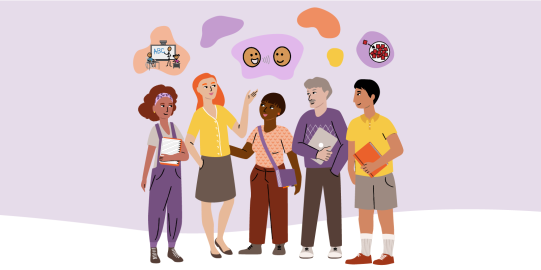AAC requires teamwork from everyone around the AAC user.
Your child will always be the center of the team and its most important member.
Could you do this alone? Yes. But it’s hard to stay motivated alone. You may begin to doubt yourself and feel isolated in carrying the responsibility of teaching your child how to communicate using AAC.
For more than thirty years, my son Josh has used AAC. We have had different AAC teams and learned how to overcome challenges with educators, medical professionals, family, and friends. During this time, we have also met a few kindred spirits along the way. Those on the same page as Josh and me from day one. Several are friends of ours to this day.
For the past 12 years, I have been supporting families for AssistiveWare. I continue to learn from them and enjoy sharing what I have learned. During this time, I’ve seen similar situations happen to many families.
Are any of these scenarios familiar to you?
- The child has started using AAC at school, but the family is unsure about using it at home.
- The family bought an iPad and Proloquo and wants the school to help teach their child how to communicate with it.
- Everyone agreed on the tool, and the school provided an iPad with the AAC app. But now it’s a new school year, and new members are on the school team, including a new teacher with very little experience and knowledge.
- The school Speech Language Pathologist (SLP) has written goals for requesting only. And they only want the AAC user to have access to 12 buttons.
Each member of the AAC team has different goals, which can sometimes lead to disagreements. When these disagreements happen, conflict arises.
Far too many families have experienced frustration and failure–mine included. I want to help identify points of conflict and provide information and ideas. This conflict can be harmful, and I want to help families avoid that.
Protect the parent/child bond
Your relationship is the most important thing. Do not let conflict with your AAC team disrupt the relationship between you and your child. Protect this bond. Do not try to be the therapist, the SLP, or the teacher. Do not sacrifice and stress this bond to “work” on therapy or academics. No one wins when that happens.
You need space to reflect on your family’s capacity before agreeing to add therapy to your routines. We must be able to say, “Right now, that won’t work for our family,” and have that be accepted.
Share information about your child with the AAC team
School team members will share information about your child’s day at school. You will need to share important information about your child outside of school. This will help the AAC team get to know your child better. Remember to protect privacy and only share those things that are helpful.
Two ideas are to share photos/videos and a communication document.
1. Take and share photos and videos
Make the time to start taking photos and videos of your child - of them communicating, of them, using AAC. Take videos of family members interacting with your child. Show how others use AAC with your child. Build an album of examples and moments of your child in action. Sharing these videos at the right moments can help. Perhaps a video shows something that works or doesn’t work. Maybe a video shows your child’s capacity to use their AAC. Perhaps a few photos to show the setup of how you keep AAC available at home.
Collaborating with the team in this way can offer insights and possible solutions to try at school.
Remember to ask permission from anyone in view when taking a photo or video. Also, ask your child’s permission before sharing any images of them.
2. Create a “How I communicate” document and keep it updated
It is important to document and share all the ways your child communicates with your AAC team. Help them understand how your child communicates. Imagine if your child was in school and no one knew they were communicating. How frustrating would that be? Let’s make sure everyone knows to recognize and attribute meaning to your child’s actions.
Here are some examples of what I wrote in Josh’s communication document:
- Josh says yes by flicking his right hand up by the wrist. It can be very fleeting. Let him know when you see it.
- When he taps the wrong button on his device, he shakes his head no. Ignore the message and continue to listen.
- If Josh starts to feel anxious, he will put his hand or fingers in his mouth and vocalize. Ask him if he needs a break.
Keep this document updated and share updates at least quarterly with the school team.
Download "How I communicate" template
Communicate with your AAC team
Collaboration requires communication. You will need to decide how and when you will communicate with different team members. Consider face-to-face team meetings, online meetings, phone conversations, emails, and group messages. Put boundaries in place to protect your family and those team members. Decide when, where, and how frequently communication should happen for your family. No one likes receiving important messages at 10 pm!
I always felt ambushed on the blacktop when I was standing with all the other parents waiting for dismissal, and the teacher or aide came out with Josh in tow, telling me what happened that day. Josh and I just wanted to get home. Despite a communication notebook and an email system in place, this scenario replayed far too frequently.
Share your preferences with the school team. Ask each member of the team members when they prefer to communicate with you and how often. At school, when passing in the hall or at lunch, the school team members can engage with one another. You do not have these opportunities.
Everyone on the team needs to know when and how each member prefers to be contacted. Many conflicts can be avoided once this is understood and accepted.
Connect with your AAC team
As you build trust and rapport with the school team members, it is important to be open and honest —to share the good and the bad. There are times when things might be challenging. You want to have the space and time to be able to express concerns but also to celebrate successes. Be sure to contribute to meeting agendas and ask that time be set aside to celebrate what is working. Collaboration gets stronger when we take the time to recognize successes!
Successful collaborations happen once you trust the other person. You need to experience school team members making meaningful connections with your child. This is why it is so important for you to keep open communication. And help them get to know your child. Meet regularly and honestly, share what’s working, and talk about what is not working.
Consider asking your child’s teacher to share photos or videos of your child using AAC in the classroom. This can help you better understand your child’s relationships at school. Sharing these photos and videos can establish a point of connection between you and the teacher. Just remember to make sure everyone in the classroom’s privacy is respected.
Know your limits
In order to collaborate, sometimes you have to meet in the middle, but other times you have to stand your ground and say no.
There could be inappropriate requests from the school team that you should decline immediately.
Examples of teacher/therapist tasks NOT to take on:
- Your child is talking too much about Minecraft at school; school team members would like to remove the folder from his AAC and ask you to redirect him when he talks about Minecraft at home.
- The school SLP would like you to offer your child something you know they don’t like, so they have to protest.
- A school therapist asks you to pretend you don’t understand what your child is telling you. They will have plenty of real communication breakdowns. No one needs a fake one.
- The teacher and aide ask you to put their favorite snack where they can see it but not reach it so they can ask you for it.
Sometimes the AAC team doesn’t work. Some members may cling to bad practices, and others may not see any benefits to AAC. This has happened to Josh and me in the past.
When the classroom teacher wanted me to remove words from Josh’s device, the team explained why it was not okay to do that. The words stayed. But the teacher lost any interest in AAC after that. There was no agreement to collaborate; the consequence was an unengaged teacher for the rest of the school year.
Some families face teachers who do not want AAC used in their classrooms. School SLPs with little AAC knowledge may insist on only having a few buttons for your child to use and refuse to add more. Administrators may not support inclusive education and deny your child access to academics. These scenarios can lead to harmful consequences, especially if parents and the school team develop an adversarial relationship.
You will have to be brave and make hard decisions. Will you stick it out? Ask for a new team? Homeschool for the rest of the school year? Change schools? File an administrative appeal or even a lawsuit?
Find community support
I bet you are a member of one or more Facebook groups with other AAC families. When a parent posts in the group and shares their troubling conflict about AAC with their child’s school team, we all empathize because we can see ourselves in the same situation. We commiserate, shake our fists, and say, “You’re right! It’s an outrage.”
I want to remind you of something: It’s important to talk them off that ledge, get them back on solid ground, and help them find their balance again. And if it is you on the ledge; listen to them and let them help.
- Learning to take your place on your child’s AAC team at school is hard.
- Putting the relationship between you and your child first is important.
- Being clear about when and how the team members will communicate is an excellent way to avoid conflicts.
- Sharing information about your child at home with school team members helps them to know your child better.
Remember, for most parents, there will be big challenges. Find a community for support and work to keep yourself and others focused on the big picture.




